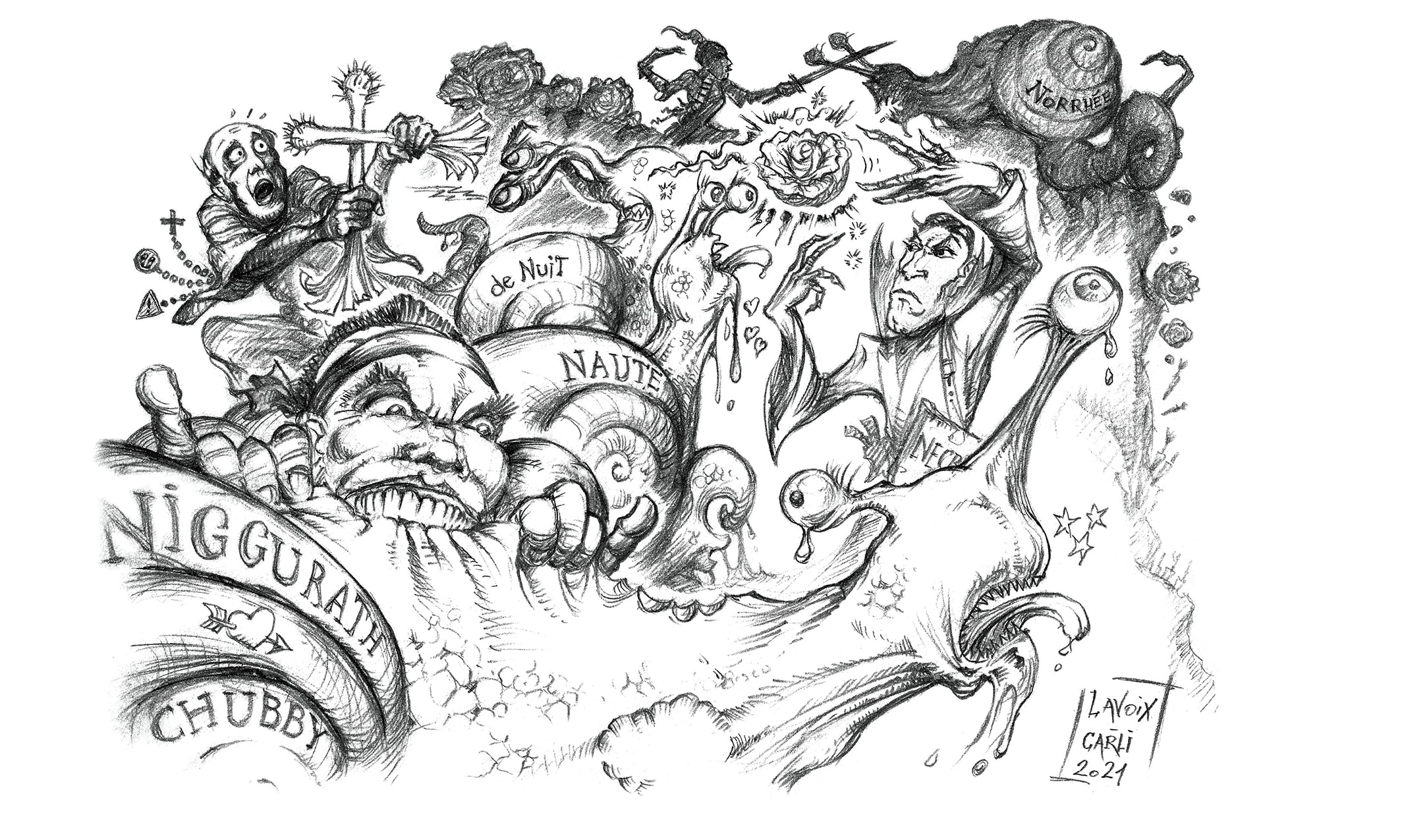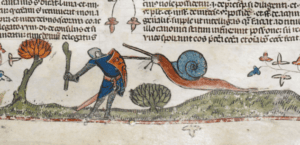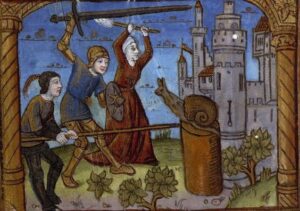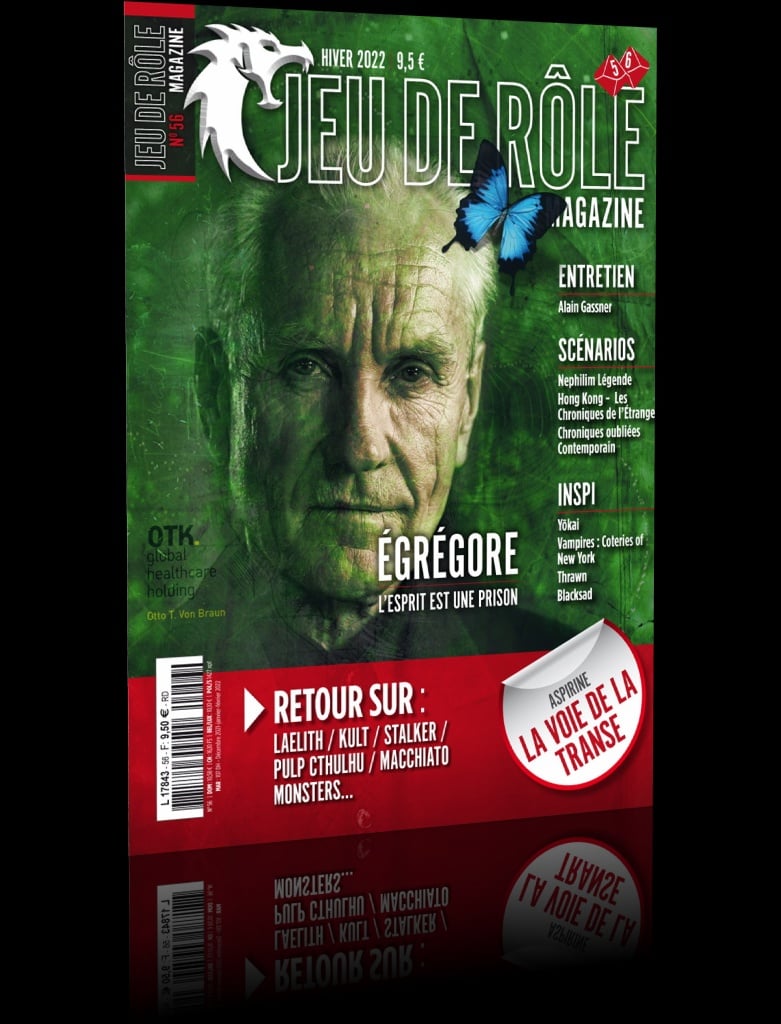
The Context
🐲 This illustration has been commissioned by a French roleplaying game magazine. This is the fourth adventure of the parody of a roleplaying party described in Episode 1. During the previous episode, the adventurers negotiated at length to NOT cross the cursed portal which led to the cursed vegetable garden to collect cursed vegetables, but they failed the negotiation. This time, they have no choice: they will have to face the guardians of the vegetable garden: giant snails (which are also cursed…).
The Illustration
After having announced a great danger beyond the portal in the previous illustration, I had to represent an epic fighting scene between the four adventurers and the giant snails… I was inspired by historical medieval illuminations which represented this kind of fights between knights and peasants against giant snails during the European middle-age; as depicted in the two images below (click to expand) :


However, in order to keep the same pictorial style as the previous episodes – and considering the large number of protagonists – I decided to decompose the image and the action into foreground scene, intermediate scene and background scene, in order to include four independent sketches in the same illustration. Narratively and pictorially speaking, it was more interesting to represent four “duels” animating the page than a pitched battle split into two monolithic camps: the snails against the adventurers. This way, the eye can better wander around the page and appreciate the temperament of each character immersed in their own battle.
Each of the snail shells also bears an individual inscription which has a double purpose: First, it allows to personalize each of the snails by giving it a form of personality, posing like the innkeeper’s “cattle” where each animal would have its own nickname, like a pet. And Second, each inscription has “added value” in the way it evokes either a pop-culture “meme” or a pun made out with the word “Escargot” (“Snail” in French).
In the foreground, I chose to focus on the Barbarian‘s victory against his own giant snail; the animal nature of the Barbarian is finally revealed as he literally devours the snail alive, like a succulent dish. I also chose to give a “cartoonish” appearance to the snails, so that they become characters in their own right – and no longer just animals – so that they can also express emotions that can serve the interaction dynamic they have with the adventurers. The pun on its shell is “Chubby-Niggurath”, an allusion to “Shub-Niggurath”, an iconic deity from H.P. Lovecraft‘s cosmogony; and it is also an allusion to the succulent texture of the snail which the Barbarian feasts on.
On the intermediate level, the Wizard enchants a cabbage by levitation in order to delay the assault of his snail, the time someone else comes to help him… or to lure the gastropod towards a possible precipice. His snail bears the inscription “Naute” to form the pun “Escargot-Naute” and therefore “Argonaut”, as if this vegetable harvest were a mythological feat…
Behind the Wizard, the Priest is in difficulty facing his own snail, which is very aggressive – even demonic – which explains the surge of faith of the Priest who tries to do a “Vade Retro” gesture by crossing two leeks to form a crucifix. His snail bears the inscription “de Nuit” to form the pun “Escargot de Nuit” (“Night Snail”), an allusion to a famous French song from the 80’s by Axel Bauer : “Cargo de Nuit”.
In the extreme background, the silhouettes of the Thief scrapping with his snail at the top of a cliff stand out, in the purest style of a swashbuckling film. This scene also allowed me to extend the perspective and the dimension of the vegetable garden as if it were an immense and infinite valley, even a magical country in its own right, which would extend beyond the portal – a strong homage to the World of Narnia. The shell of his snail bears the inscription “Norrhea” to form the pun “Escargot-Norrhea” and therefore “Gonorrhea”, which is a sexually transmitted infection… this snail being particularly infected, it is better that our thief dispose of it as quickly as possible! Note that the position of the off-hand of the Thief and the tip of the snail’s tail are mirroring each other, typical of an “En Garde” fencing position.

This post belongs to the Category :
Check my latest posts!
- Article Header Design: “Niger: a New Severe Threat for the Future of France’s Nuclear Energy?”
- Article Header Design: “Revisiting Uranium Supply Security”
- Article Header Design: “The Future of Uranium Demand – China’s Surge”
- Article Header Design: “Uranium and the Renewal of Nuclear Energy”
- Article Header Design: “The Return of Nuclear Energy”
Check the latest comments!
Thank you very much for your comment coming from an IT expert, Nouha!
Very interesting article and excellent choice for th Sphinx!!
Splendid as always! And also this showcase the very broad scope of your design skills!
Related Themes :
Related Links :
Your comment will be posted after approval







Leave a Comment